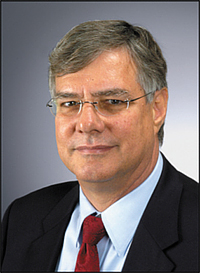Why We Asked to Extend the Transition
RESTON, VA.
When Sprint recently joined with the NAB, Association for Maximum Service Television (MSTV) and SBE to request an extension of the BAS transition deadline to February 2010, I was struck by two things. First, how much progress we've made in the approximately 18 months since we filed our original extension request with the FCC, and second, the number and scope of unforeseen obstacles that we are continually overcoming to complete the transition.

Michael Degitz By any measure, we have made great strides since filing the original extension request in September 2007. The Frequency Relocation Agreement (FRA) process is completed for 99 percent of eligible BAS licensees, a 120 percent increase. Nearly all BAS licensees (99 percent) have submitted purchase orders for their BAS replacement equipment, a 148 percent increase since the first extension request. Seventy-five percent of all equipment has been delivered, 62 percent of BAS licensees have all the equipment necessary to relocate, and 51 percent of licensees have installed their equipment, a 628 percent increase from September 2007.
NEEDS MORE TIME
Overall, 36 percent of BAS licensees have completed the transition. The transitioned licensees span 79 television markets—including four of the top 10 markets—covering a population of more than 106 million. In those markets yet to be transitioned, hundreds of licensees have already installed replacement BAS equipment or are actively working with vendors and manufacturers to complete the equipment fulfillment and installation process.
The transitioned markets have proven that the new BAS equipment and band plan meet broadcasters' newsgathering needs and that markets can be transitioned with little disruption to BAS operations. Once transitioned, nearly all broadcasters find that the new equipment provide excellent picture quality and enable remote shots in areas that previously experienced at best, marginal analog newsgathering coverage.
Importantly, this success has helped build confidence in the BAS transition throughout the broadcast community and has generated even greater momentum toward completing relocation. Still, despite the best efforts of Sprint and the vast majority of broadcasters, it is clear that completing the BAS transition will require an extension to February 2010. (Editor's note: Feb. 27, the FCC approved a 45-day extension to April 19, 2009.)
The BAS transition remains a complex undertaking with new challenges and obstacles arising at every turn. When it extended the deadline to March 2009, the FCC acknowledged that a multitude of factors beyond the control of Sprint and broadcasters has caused unanticipated delays and that it would consider granting additional time to complete the transition.
Certainly the delay of the DTV transition is a prime example of the ongoing challenges that arise. In developing the BAS transition plan, Sprint and broadcasters considered the interdependence of the two transition processes and planned the BAS transition around the February 2009 DTV transition. The postponement of the DTV transition to June 12, 2009 creates conflicting demands for the limited pool of trained technicians available to complete both transitions and only adds to the time needed to complete the BAS transition since the FCC has made clear that the DTV transition is the first priority. As a result, vendors working on both the BAS and DTV transitions have been directed to focus their time and attention on the DTV transition.
"DTV is taking precedence," said Tim Carroll of DSI RF Systems Inc., a major 2 GHz BAS vendor, recently. "If there's an issue of our having to do both [DTV and BAS transitions]…. we take the BAS [transition] second.
The very limited availability of vendors and contractors makes it more important for broadcasters to ensure that they complete their installations as soon as their equipment is delivered and vendors become available. Experience has shown that nearly every installation takes longer and encounters more difficulties than expected. New systems may be missing certain pieces to work correctly when first installed and might need to be "re-engineered." Remote receive sites may not have the telecommunications infrastructure in place to support the increased data speeds the new systems require. Vans may need to be retrofitted to accommodate the increased size and weight of the new amplifiers. These and other circumstances take time to overcome and can easily wreck havoc on market schedules.
For many markets, this summer will be a key time for broadcasters to complete their installations and I encourage everyone to continue to press through the challenges and complexities that we face. The substantial progress of the past year and a half demonstrates that if we remain committed to the task, we are well on the road to completion.
Michael Degitz is vice president of spectrum management with Sprint Nextel.
For additional information on the 2GHz BAS relocation, visitwww.2GHzRelocation.com.
The professional video industry's #1 source for news, trends and product and tech information. Sign up below.
